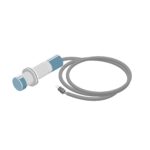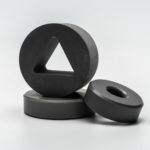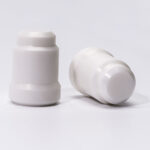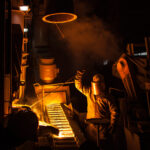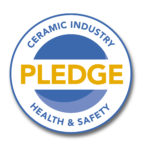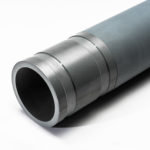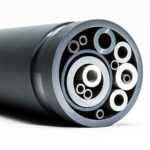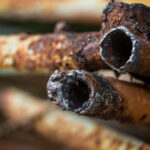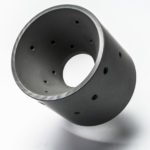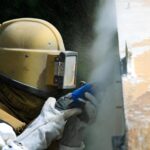Silicon nitride and alumina are advanced ceramic materials frequently used to produce faceplates in the aerospace, automotive, and electronics industries. Faceplates, often called technical ceramic plates, are crucial and common as they are the outer layer of a component designed to protect the internal structure from abrasive media, corrosive environments, or extreme temperatures. Their secondary function is to provide insulation and help regulate the temperature within a device or component. Throughout this blog post, we will look at the similarities and differences between silicon nitride and alumina and why they are suitable for engineering faceplates.
Enduring High Temperatures in Industry with Advanced Ceramics
Advanced ceramics are ideal materials for high-temperature applications because of their low thermal expansion, wide ranging thermal conductivity, and ability to withstand extreme temperatures under high loads without enduring damage. There are several families of advanced ceramics, including ultra-high temperature ceramics (UHTCs), which are known for maintaining their stability at temperatures of over 2000oC. Advanced ceramics are suitable for various demanding industrial processes, during which materials and equipment are subjected to high temperatures that could result in oxidation, creep, deformation, or complete failure if their properties do not suit the applications. This blog post will look at how advanced ceramics are used in industry to overcome high-temperature processes.Continue reading
Why Advanced Ceramics Excel in High-Temperature Environments
Advanced ceramics are inorganic materials that possess specific, high-performance properties. Because of these properties, advanced ceramics play a vital role in many industries and high-temperature environments, such as electronics, metal production, power generation, and other industrial processing sectors. This blog post will analyse what makes advanced ceramics superior materials for high-temperature environments.Continue reading
How High-Temperature Resistant Materials Function
Heat is an essential aspect of numerous industrial processes: turbines and generators often operate most effectively at higher temperatures; many key chemical process industry (CPI) reactions occur at extreme temperatures; extruded, pressed, and welded metal parts are routinely formed when heated to the point of plasticity. These are just a few examples where temperatures exceeding many hundreds of degrees are routinely generated and sustained. Naturally, all these applications require high-temperature resistant materials that can withstand the enormous thermal shock and long-term stresses associated with these extreme environments. So, how exactly do they work?Continue reading
BCC – Pledge Conference and Awards 2022
International Syalons are delighted to receive two awards at the British Ceramic Confederation health and safety Pledge conference and awards event in Stoke-on-Trent on 12th October 2022.
Corrosion Resistant Ceramics Case Studies
Corrosion-resistant ceramics are often mandatory in harsh environments, namely in the oil and gas industries. This is because ceramics provide high levels of corrosion and thermal resistance and have outstanding wear, and these fundamental properties make them more suitable than traditional metal components.Continue reading
Are Ceramics Corrosion Resistant?
Ceramics are the preferred materials for use in harsh environments because they are highly resistant to corrosion and wear. Aside from being corrosion and wear-resistant, advanced ceramics can also withstand high temperatures, pressures and other extreme conditions. Throughout this blog post, we will look at how corrosion-resistant ceramics are used in the oil and gas industries and what benefits this provides.Continue reading
9 Different Types of Corrosion Affecting Materials
Corrosion is the process by which a material deteriorates due to chemical interactions. All materials are subject to corrosive phenomena, but metals are especially prone to corrosion as surface atoms readily oxidise in specific conditions. There are steels designed to utilise oxidation for corrosion resistance (i.e. weathering steel) and other grades with regenerative patinas engineered to reduce surface corrosion (i.e. stainless steel). But few engineering-grade steels can match advanced, corrosion-resistant ceramics in terms of chemical stability. Continue reading
Wear in Industry: Advanced Ceramic Case Studies
Update: Originally posted in 2022, this blog was updated with new context on 27/03/2024.
Careful material selection is essential in sectors using heavy machinery or extreme processing temperatures. Advanced ceramic materials are instrumental in mitigating or diminishing wear in industrial environments. This blog will discuss a broad spectrum of wear mechanisms, highlighting how advanced ceramics outperform traditional ceramics in combating wear. Specific attention will be paid to the role of advanced ceramic materials in resisting abrasive wear, where hard particles remove material from the surface, and adhesive wear, characterized by strong adhesive forces between sliding surfaces. Additionally, we will address how these materials withstand corrosive wear, which involves chemical or electrochemical reactions at the surface.
Continue reading
Advanced Ceramics and Wear Prevention
Industrial processes are dictated by different, often conflicting, needs. Maximising throughput demands minimal downtime. But eliminating downtime is impossible when tools require maintenance to function at optimal levels. However, optimal functionality underlies desired yields and, of course, throughput. There is a cyclical nature to the demands of high-performance industrial components, but there is also a very clear throughline: maximising durability is critical to true quality assurance and profitability. Hence wear prevention is a critical factor impacting a wide range of end-to-end performance parameters.
Continue reading
